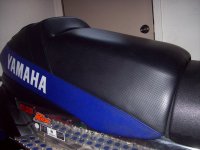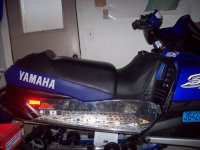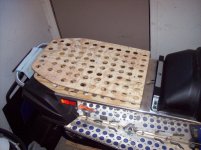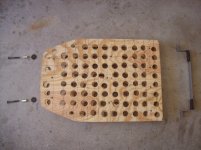One of my summer projects was to build a seat riser. My riser is a combination of seat riser and extra foam mod seat top for under $27 bucks.
Seat Riser
Demension 2" in front and 3" in rear
2 pcs of 1/4 plywood - cut to underside of seat: $6
1 1/2 x 14 of trim wood for front of riser: $1.50
1" plastic pipe cut on angle to 2 1/2 for rear bolts: .67c
3 - cans of expand foam that hardens (red can): $15
2 - 55mm bolts 10.9: free
2 - 55mm coupler nuts: free
2 - 1/2 plastic washers: free
7 - sticks of hot glue sticks: $2.00
Vinyl: free
Foam 1": $3.60
1" - Galvanized steel strap: $3.00
Closed cell dense foam: $ 4.50
Cut the front wood support and the rear plastic supports measured to get the spec of 2" in the front and 3" in the rear edge. Drill a hole for the rear bolts. The plastic supports will go over the hole. Cut extra wood supports: 3 pcs in the center and 4 pcs in the rear past the plastic supports. Screw the supports in the top and bottom. Hot glue all supports. Drill 1" holes: 8 accross from front to back, top and bottom. Spray foam the riser and let DRY for 24 hours. Keep and eye on the rise of the foam so the riser does not expand. Cut off excess foam and paint. Use 1" foam around the edge. On one side make a 1/2" edge that goes around the top edge to cover the gap. Then staple the vinyl over the foam. Duck tape the staples.
The steel strap is measured to the riser and seat height tabs and fastened by using the gas tank bolts. The strap allows the front seat tabs to hook under and secure the front of the seat. You have to measure the height to make sure your strap fits your gap. Cut the closed cell foam to fit around the edge of the tank to take up the gap between the seat and the tank.
Assemble the the riser by using a plastic washer, existing seat nuts and coupler nuts to the seats old studs. Seat riser and seat and bolts with plastic washers.
Foam 1" added to the top of the Seat
Bought a 1" thick by 14" by 20" to the top of the Viper seat. Use mesh sandpaper used for drywall sanding to sculpt the edge to a bevel 45 degree on the sides. Take the seats front staples out. I wrapped the foam in a slippery packing paper and put it in the seat. Positioned it to te exact spot and pulled out the paper. I used super stickie double sided tape in between the foam the full length in 3 strips. Restaple. Make sure you have room to add the foam to your seat.
The combination of the seat riser and foam gives the seat a close 3" in the front and 4" in the rear. Overall, the seat fits great and gives the sled a more rider forward position for me.
The pictures show the seat completed, wood with the holes, and supports prior to foam. Bracket for the lip of the seat that fastens to the tank bolts.
Thanks to Bearit for original concept.
Seat Riser
Demension 2" in front and 3" in rear
2 pcs of 1/4 plywood - cut to underside of seat: $6
1 1/2 x 14 of trim wood for front of riser: $1.50
1" plastic pipe cut on angle to 2 1/2 for rear bolts: .67c
3 - cans of expand foam that hardens (red can): $15
2 - 55mm bolts 10.9: free
2 - 55mm coupler nuts: free
2 - 1/2 plastic washers: free
7 - sticks of hot glue sticks: $2.00
Vinyl: free
Foam 1": $3.60
1" - Galvanized steel strap: $3.00
Closed cell dense foam: $ 4.50
Cut the front wood support and the rear plastic supports measured to get the spec of 2" in the front and 3" in the rear edge. Drill a hole for the rear bolts. The plastic supports will go over the hole. Cut extra wood supports: 3 pcs in the center and 4 pcs in the rear past the plastic supports. Screw the supports in the top and bottom. Hot glue all supports. Drill 1" holes: 8 accross from front to back, top and bottom. Spray foam the riser and let DRY for 24 hours. Keep and eye on the rise of the foam so the riser does not expand. Cut off excess foam and paint. Use 1" foam around the edge. On one side make a 1/2" edge that goes around the top edge to cover the gap. Then staple the vinyl over the foam. Duck tape the staples.
The steel strap is measured to the riser and seat height tabs and fastened by using the gas tank bolts. The strap allows the front seat tabs to hook under and secure the front of the seat. You have to measure the height to make sure your strap fits your gap. Cut the closed cell foam to fit around the edge of the tank to take up the gap between the seat and the tank.
Assemble the the riser by using a plastic washer, existing seat nuts and coupler nuts to the seats old studs. Seat riser and seat and bolts with plastic washers.
Foam 1" added to the top of the Seat
Bought a 1" thick by 14" by 20" to the top of the Viper seat. Use mesh sandpaper used for drywall sanding to sculpt the edge to a bevel 45 degree on the sides. Take the seats front staples out. I wrapped the foam in a slippery packing paper and put it in the seat. Positioned it to te exact spot and pulled out the paper. I used super stickie double sided tape in between the foam the full length in 3 strips. Restaple. Make sure you have room to add the foam to your seat.
The combination of the seat riser and foam gives the seat a close 3" in the front and 4" in the rear. Overall, the seat fits great and gives the sled a more rider forward position for me.
The pictures show the seat completed, wood with the holes, and supports prior to foam. Bracket for the lip of the seat that fastens to the tank bolts.
Thanks to Bearit for original concept.
Attachments
Last edited:
rancidjo
New member
looks good!! I am going to do a very similar mod to my viper this year. Your tips will help my project to go a little easier.
TopGunnSrx
New member
Looks good man!
Wanna do one for my srx LOL
Wanna do one for my srx LOL
rancidjo email with any questions for your riser.
topgunsrx thanks.
topgunsrx thanks.
rancidjo
New member
once I start my project I will likely email you...thanks
do you have some in progress pics?
do you have some in progress pics?
SRX RIDER
New member
Great pics and write up. If I can manage to get the 04' S home for the wife I'm going to consider doing this myself. I've even got an Excell on mine to use for measurements, so it should be pretty easy.
Seat looks great too! Nice work.
Seat looks great too! Nice work.

aj,
Hey I just wanted to drop a line on how the new seat riser was this weekend. I really like the riser, it made the sled feel totally different. My riser went from 2X3 with a 1" add foam to the top of the seat too! It was real comfortable. I wished I would have made it sooner. I rode the sled for 400 miles in all types of conditions.
viper7mi
Hey I just wanted to drop a line on how the new seat riser was this weekend. I really like the riser, it made the sled feel totally different. My riser went from 2X3 with a 1" add foam to the top of the seat too! It was real comfortable. I wished I would have made it sooner. I rode the sled for 400 miles in all types of conditions.
viper7mi
sxr_rida
New member
can i do this on a 2000 sxr 700?
yamaha4evr
New member
wow thats a really nice seat riser i would really like one on my 2000 sxr 600
This seat riser mod will work on any viper, sx or srx. Just cut to the contor of the seat. Best of luck.
PenguinLuke33
New member
viper7mi said:aj,
Hey I just wanted to drop a line on how the new seat riser was this weekend. I really like the riser, it made the sled feel totally different. My riser went from 2X3 with a 1" add foam to the top of the seat too! It was real comfortable. I wished I would have made it sooner. I rode the sled for 400 miles in all types of conditions.
viper7mi
Where did you go riding????

staggs65
Moderator
wow this post was dug deep from the attic
Sometimes it's good to dust off old posts when they are useful!
Wow you are right. The riser is a great way to totally change how your Viper feels. Your knees will thank you.

staggs65
Moderator
Sometimes it's good to dust off old posts when they are useful!
i agree, just making an observation
PenguinLuke33
New member
Im gonna do this to my 04 sx viper S I decided, Do you think that the extra foam in the seat helps alot or would it be better if I just made the riser 4inch in the back and 3inch in the front instead?
The extra foam was only 1" but I think it a differnece.
brosenberg69
New member
So can you clarify the 1" of foam to the seat? Did you take the cover off, add some foam and then put the cover back on? And the cover fit?viper7mi said:The extra foam was only 1" but I think it a differnece.
Thanks - thinking about doing this but need to plan a bit and get it all figured out in my head.
I left the cover on the sled except the front edge that I unstapled. I cut the 1" foam then shaped. I had some slippery packing foam that cam from a UPS ship box. It is in sheets and sandwiched the foam, then grabed the end the of foam that goes to the end of the seat and pulled it into the seat. Then I slowwwwly pulled the sheet out holding the foam with other hand.
I rode the sled all over Michigan.
I rode the sled all over Michigan.






